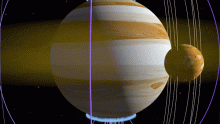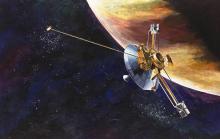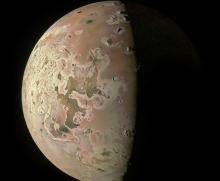Listen to today's episode of StarDate on the web the same day it airs in high-quality streaming audio without any extra ads or announcements. Choose a $8 one-month pass, or listen every day for a year for just $30.
You are here
Moon and Jupiter
Brilliant Jupiter — a planet that’s like the hub of a mini solar system — stays close to the Moon tonight. They climb into good view by about 11 p.m. and arc across the south later on.
Jupiter is far more massive than all the other planets in the solar system combined. In fact, it’s like the center of its own miniature solar system. It has about 80 known moons, a powerful magnetic field, and a big influence on the rest of the solar system.
Most of Jupiter’s moons are just big chips of rock. But several of the moons are fascinating worlds in their own right — like small planets. One is covered with volcanoes, while another has an ocean of liquid water beneath its icy crust.
Jupiter’s magnetic field is powerful — only the Sun’s is stronger. And its gravity is powerful as well. It helped push the planets into their current orbits, and helps keep them there. It sometimes pulls in asteroids or comets, or rips them apart if they get too close.
Jupiter is composed mainly of hydrogen and helium — the same elements as the Sun. And the proportions are about the same as well. That means Jupiter probably formed quickly, from the initial cloud of gas and dust that gave birth to the Sun.
Today, the planet emits more energy than it receives from the Sun — just like a star. And if it had grown to about 75 times its current mass, it would have ignited the fires of nuclear fusion and become a star — giving the Sun a sibling.
Script by Damond Benningfield





